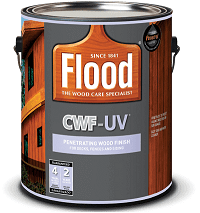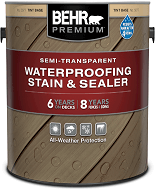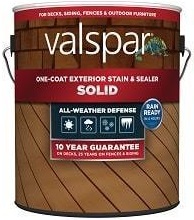Battering rain, harsh UV rays, temperature changes, and many more elements can take a toll on your wood deck. This leaves it dull and faded and can even cause extreme damage, such as wood rot and plank splitting.
A deck stain can not only restore a deck, but it can also protect the wood from these elements. Choosing the right deck stain important, and in this article, we review several best deck stains we’ve tested.
Our Top Deck Stain Picks
- Best Overall Deck Stain: Ready Seal Natural Cedar Exterior Stain
- Best Water-Based Deck Stain: Defy Extreme Wood Stain
- Best Transparent Deck Stain: Flood Exterior Wood Finish
- Best Semi-Transparent Deck Stain: BEHR PREMIUM Slate Wood Stain & Sealer
- Best Solid Color Deck Stain: Valspar Quiet Chamois Solid Exterior
Oil-Based vs. Water-Based Deck Stains
The two main types of deck stains you’ll encounter are oil-based and water-based. Both have pros and cons, which you should consider when picking the right one for your deck.
Oil-Based Stains
Oils-based deck stains have been around for a while and are easy to apply and maintain. However, they usually fade away over time and require to be reapplied every year for the best results. Because the dry time of oil-based stains is longer, they provide an even finish and penetrate the wood easily. Also, once they penetrate the wood, they resist peeling better than water-based stains.
However, oil-based stains are not as durable as water-based stains and contain volatile organic compounds or VOCs, which can harm the environment. They also take longer to dry, which can disadvantage those living in humid climates or who want to use the deck. They are also flammable when wet, so avoid smoking and stay away from an open flame when applying them.
Best Overall Deck Stain
This is an oil-based stain and sealer that is semi-transparent, enhancing your wood's natural beauty. It is easy to apply, and this can be achieved using a brush, roller, or sprayer. The semi-transparent color looks good and protects a outdoor wood from damage against UV rays.
Water-Based Stains
Water-based stains are relatively new in the market but have grown in popularity. This is because they have better UV protection, are harder to fade than oil-based stains, are non-flammable, dry faster, have fewer odors, and are environmentally friendly. Water-based stains are also breathable, not allowing moisture in the wood to be trapped.
While they have many advantages, water-based stains require more care during application. Using shortcuts can make a water-based stain fail by peeling or flaking off. Because the water molecules are bigger than oil molecules, it makes it harder for water-based stains to penetrate the wood. For this case, ensure water-based stains are properly brushed for better penetration.
Best Water-Based Deck Stain
With seven different colors to choose from, not only does this wood stain look great, but it also provides excellent protection against different elements. It's easy to apply and offers excellent performance over time. The Defy Extreme wood stain is an excellent water-based stain that will protect and restore the look of your deck.
Deck Stain Opacity
This is the degree of opaqueness or transparency of a wood stain. The opacity of a wood stain will determine how it looks when finished and how well the stain will protect your deck.
Transparent and clear deck stains are best for new decks or where you want to highlight the natural beauty of the wood. For best protection, transparent and clear stains should be reapplied every year.
Best Transparent Deck Stain
If you're looking for a good transparent deck stain finish to enhance the appearance and beauty of your deck, this is it. The stain looks particularly great for deck rails and fences.
Semi-transparent stains are the most popular types of stains in the market. They add a noticeable color to your deck but still allow the wood grain to show off. They should be reapplied every 2-3 years to offer the best protection.
Best Semi-Transparent Deck Stain
Semi-transparent stains offer adequate protection while still enhancing the beauty of your deck. This stain is easy to apply, has generous coverage, holds up well, and easily cleans up with soap and water.
Semi-solid or semi-opaque deck stains have more color pigment, which can cover most of the wood grain. They are best for hiding modest wear and tear and offer outstanding protection against UV rays. For the best protection, semi-solid deck stains should be reapplied every 3-4 years.
Solid deck stains are also known as opaque deck stains. These have the highest color pigment percentage and can protect a deck the longest, requiring it to be recoated every 4-5 years. They are also very dense and will hide the wood grain and any imperfections on the surface. Because solid deck stains sit on top rather than penetrating, they are prone to peeling.
Best Solid Color Deck Stain
This Valspar deck stain is available in eight different colors. It is excellent for hiding deck surface imperfections and offers better protection against elements like UV. It is also hard to wear and should be long lasting.
Deck Stain vs. Sealer
Wood stains and sealers are different, despite what most people think. Both have a general purpose of preserving and protecting wood, but they also have their difference.
Deck sealers are transparent or clear, and it penetrates or forms a clear protective film on top. Sealers help lock out moisture and also reduce water penetration. This helps prevent the wood from rotting or the growth of mold and mildew.
Deck stains are sealers that have added color pigment in them. The color pigments add color and also enable protection against UV light, which can cause wood to crack and fade over time. The opacity of a stain can range from clear/transparent to solid/opaque. The darker the stain color, the better it will protect against UV damage.
Staining a New vs. Old Deck
Once your new deck is complete, it might be tempting to apply a stain to protect it from damage immediately. However, this is not the way to go. A new deck should go at least 4 or 6 months before you can stain it. This is because a new deck built with fresh wood is full of moisture which can reduce how effectively a stain penetrates the wood.
This is the same for a pressure-treated deck. Give it time to dry out before staining it. The longer the deck stays, the better it will be prepared to receive a deck stain.
For a new deck, once the waiting time has gone by, you can choose different staining options. If you’d like to show the beauty of the wood, a semi-transparent deck option is a good option. However, you can also choose a solid stain option offering enhanced protection.
For an old deck, before staining, you need to remove the existing stain with a stain remover and clean it off with a pressure washer. Once you’ve stripped the old stain, use a wood brightener or a good wood cleaner to restore the deck’s appearance and aslo open up the deck surface ready to receive a new stain.
A solid deck stain is the better option for older decks with weathered wood and many imperfections. It will hide flaws and brighten the look of the deck. An oil-based deck stain will penetrate the wood fibers deeper and offer better protection against elements such as UV light and rain.
How Long for Deck Stain To Dry?
A deck stain takes an average of four to 24 hours to completely dry before you can repaint a second coat. However, this depends on the type of stain used, the weather conditions, and the type of wood and its age. Check out our informative read on deck stain drying time. We also have some tips you can learn to help make a deck stain dry faster.
Deck Stain Applicators
There are different deck stain applicators you can choose from. Brushes, rollers, stain pads, and sprayers can also be used to apply a deck stain. Each of these has pros and cons that you should consider before deciding on the best option.
- Using brushes to stain a deck is one of the most popular methods. Brushes offer more control, and the friction between the bristles and wood helps the stain gets absorbed deeper into the wood fibers.
- Rollers offer better coverage in less time but are mostly not designed to hold deck stains. If you’re using a roller for staining a deck, consider using a brush afterward to work the stain into a small crack.
- For a faster method of staining your deck, spraying your deck is the best option. It helps you cover a larger surface in less time and get a uniform finish. However, you’ll have to deal with overspray and use more paint due to waste.
Check out our informative guide on the best deck stain applicators to help you make an informed decision. We review the different deck stain applicators, from brushes, rollers, and sprayers.





